The Chinese evergreen hanging plant, known for its striking foliage and air-purifying qualities, takes center stage in this comprehensive guide. We delve into its botanical origins, explore its unique characteristics, and provide expert advice on care, maintenance, and decorative applications.
From ideal growing conditions to effective propagation techniques, this guide empowers you to cultivate a thriving Chinese evergreen hanging plant that will enhance your living spaces and bring a touch of nature indoors.
Botanical Overview
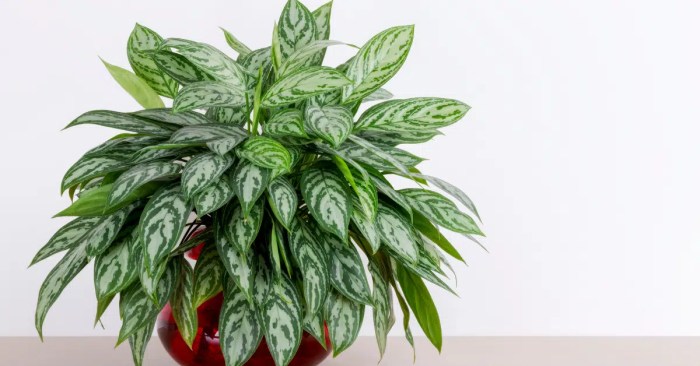
The Chinese evergreen hanging plant, scientifically known as Aglaonema commutatum, is a popular choice for indoor spaces due to its hardiness and attractive foliage.
Originating from the tropical rainforests of Southeast Asia, this plant features lance-shaped leaves with variegated patterns of green, white, and silver. Its leaves are typically 4-8 inches long and 2-4 inches wide, with smooth edges and a leathery texture.
Unique Features
Unlike many other hanging plants, the Chinese evergreen does not require direct sunlight and can tolerate low-light conditions. It is also known for its ability to purify the air, removing harmful toxins like benzene and formaldehyde.
Additionally, the Chinese evergreen is relatively low-maintenance, making it a great choice for beginners or those with busy schedules. It prefers well-drained soil and moderate watering, and can tolerate occasional neglect.
Care and Maintenance
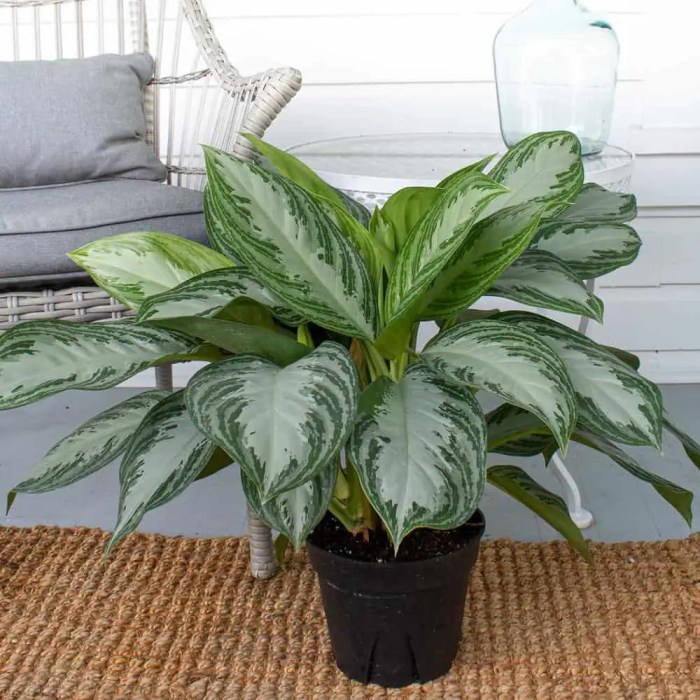
The Chinese evergreen hanging plant thrives in specific growing conditions to maintain its vibrant foliage and trailing growth habit. Understanding and meeting its needs are crucial for optimal growth and well-being.
Ideal Growing Conditions
Light Requirements:Chinese evergreen plants prefer bright, indirect light. Avoid placing them in direct sunlight, as this can scorch their leaves. They can also tolerate low light conditions, but growth may be slower.
Temperature:These plants prefer warm temperatures between 65-85°F (18-29°C). Avoid exposing them to temperatures below 55°F (13°C), as they can suffer cold damage.
Humidity:Chinese evergreen plants appreciate high humidity levels. Regular misting or placing them on a pebble tray filled with water can help increase humidity around the plant.
Chinese evergreen hanging plants are a popular choice for their low-maintenance care and ability to thrive in various lighting conditions. They make excellent additions to any room, especially when used as trailing plants for walls. For more inspiration on trailing plants suitable for vertical surfaces, consider exploring our comprehensive guide on the best trailing plants for walls . Chinese evergreen hanging plants remain a versatile option for both beginners and experienced plant enthusiasts, offering a touch of greenery and elegance to any space.
Watering Schedule:Water the plant when the top inch of soil feels dry to the touch. Avoid overwatering, as this can lead to root rot. During winter months, reduce watering frequency.
Fertilization:Fertilize the plant monthly during the growing season (spring and summer) with a balanced liquid fertilizer diluted to half strength. Avoid fertilizing during the winter months.
Pruning Techniques:Pruning is necessary to maintain the plant’s shape and encourage new growth. Remove any dead or yellowing leaves and prune back overgrown stems to promote bushier growth.
Decorative Applications
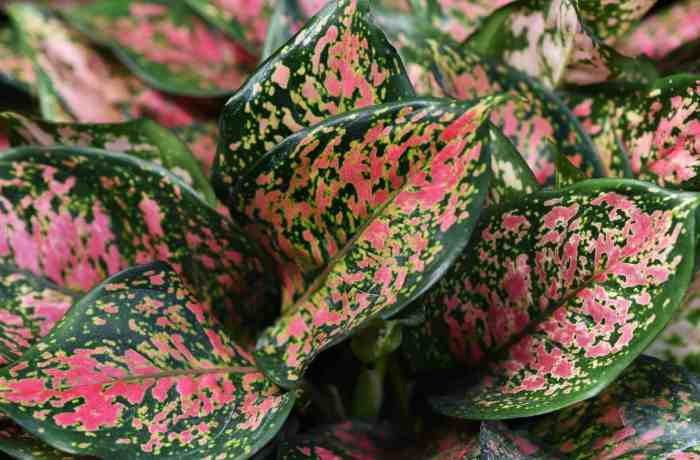
The Chinese evergreen hanging plant offers a plethora of decorative applications, enhancing the aesthetics of both interior and exterior spaces. Its versatility allows it to complement a wide range of home decor styles, from traditional to modern.
The Chinese evergreen hanging plant, known for its glossy leaves and trailing vines, is a popular choice for indoor spaces. If you’re looking for more hanging plant options, check out best hanging plants for indoor . The Chinese evergreen hanging plant is a low-maintenance plant that can tolerate low light conditions, making it ideal for those who may not have a lot of natural light in their homes.
In interior settings, the plant’s cascading foliage adds a touch of greenery and life to living rooms, bedrooms, and hallways. Its trailing stems can be draped over shelves, windowsills, or macrame hangers, creating a sense of movement and visual interest.
Complementing Home Decor Styles
- Traditional:The Chinese evergreen’s lush foliage pairs well with classic furniture and ornate accessories, adding a touch of natural beauty to traditional living spaces.
- Modern:Its clean lines and geometric shape make it a perfect fit for modern interiors, complementing minimalist furniture and sleek accents.
- Bohemian:The plant’s trailing stems and vibrant foliage add a touch of whimsy and bohemian flair to eclectic spaces, blending well with macrame, woven textiles, and ethnic patterns.
Outdoors, the Chinese evergreen hanging plant can be used to create lush vertical gardens on patios, balconies, and porches. Its ability to tolerate shade makes it an ideal choice for areas with limited sunlight, adding a touch of greenery to shaded nooks and corners.
Propagation Methods
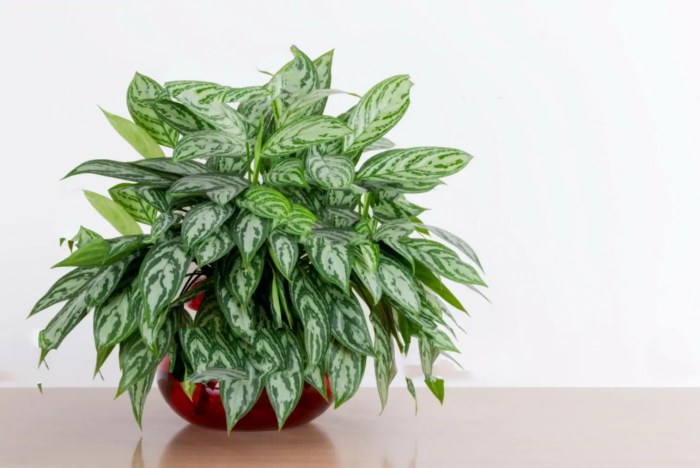
Propagating Chinese evergreen hanging plants can be done through various methods, including stem cuttings, air layering, and division. Each technique offers a unique approach to creating new plants while maintaining the desirable characteristics of the parent plant.
With its rich, dark green leaves and trailing growth habit, the Chinese evergreen hanging plant is an attractive choice for window treatments. Its ability to thrive in low light conditions makes it ideal for spaces that receive limited natural sunlight.
If you’re looking to explore more options for hanging plants that can enhance your window views, be sure to check out our comprehensive guide to best hanging plants for windows . The Chinese evergreen hanging plant remains a top choice for its ease of care and ability to add a touch of greenery to any room.
Stem Cuttings
Stem cuttings involve taking a portion of a healthy stem from the parent plant and rooting it in a suitable medium. The stem should be at least 4 inches long and have several nodes. Remove the leaves from the bottom inch of the stem and dip the cut end into a rooting hormone.
Plant the cutting in a well-draining potting mix and keep it moist. Roots will typically form within a few weeks, and the new plant can be transplanted once established.
Air Layering, Chinese evergreen hanging plant
Air layering is a technique that involves rooting a stem while it is still attached to the parent plant. A small incision is made on a healthy stem, and a rooting medium is applied to the wound. The area is then wrapped with plastic wrap or foil to maintain moisture.
Roots will develop within a few weeks, and the rooted stem can be cut from the parent plant and planted in its own pot.
Division
Division is a method of propagation that involves separating an existing plant into smaller sections. The plant should be carefully dug up and divided into sections, each with its own root system. The sections can then be planted in individual pots and grown as separate plants.
Troubleshooting Common Issues: Chinese Evergreen Hanging Plant
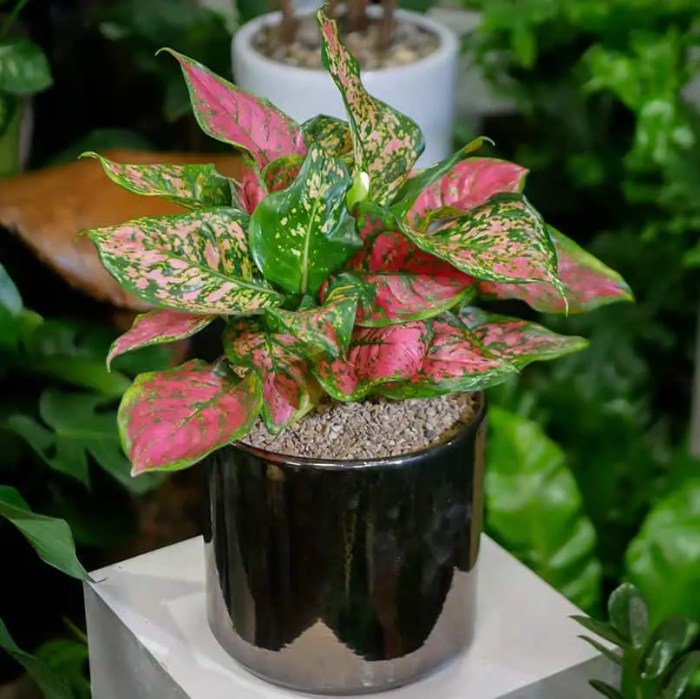
The Chinese evergreen hanging plant is generally hardy and low-maintenance, but like all plants, it can encounter occasional problems. Identifying and addressing these issues promptly is crucial to maintain the plant’s health and aesthetic appeal.
Common issues include pests, diseases, and nutrient deficiencies. Understanding the symptoms and causes of these problems enables effective troubleshooting and preventive measures.
Pests
- Aphids:Small, green or black insects that cluster on new growth and stems, causing yellowing and stunted growth. Use insecticidal soap or neem oil for control.
- Mealybugs:White, cottony masses that attach to stems and leaves, sucking plant sap. Apply rubbing alcohol or insecticidal soap to remove them.
- Spider mites:Tiny, spider-like pests that create fine webs on the underside of leaves, causing yellowing and stippling. Use insecticidal soap or horticultural oil for treatment.
Diseases
- Root rot:Caused by overwatering or poor drainage, leading to yellowing leaves, wilting, and mushy roots. Improve drainage and reduce watering frequency.
- Leaf spot:Fungal disease that causes brown or black spots on leaves, which eventually drop. Remove affected leaves and apply fungicide.
- Botrytis blight:Gray mold that affects leaves, stems, and flowers in humid conditions. Improve air circulation and remove infected plant parts.
Nutrient Deficiencies
- Nitrogen deficiency:Yellowing of older leaves, stunted growth. Fertilize with a balanced fertilizer containing nitrogen.
- Potassium deficiency:Yellowing of leaf margins, brown leaf tips. Fertilize with a fertilizer containing potassium.
- Magnesium deficiency:Yellowing between leaf veins, purple or red leaf margins. Fertilize with a fertilizer containing magnesium.
Closing Summary
Whether you’re a seasoned plant enthusiast or just starting your gardening journey, this guide to the Chinese evergreen hanging plant will provide you with the knowledge and inspiration you need to create a vibrant and thriving indoor oasis.
Question Bank
How often should I water my Chinese evergreen hanging plant?
Water thoroughly when the top inch of soil feels dry to the touch. Avoid overwatering, as this can lead to root rot.
What is the ideal temperature range for a Chinese evergreen hanging plant?
Chinese evergreen hanging plants thrive in temperatures between 65-80°F (18-27°C).
Can I propagate a Chinese evergreen hanging plant from cuttings?
Yes, stem cuttings can be used to propagate new plants. Take cuttings in spring or summer and root them in moist potting mix.